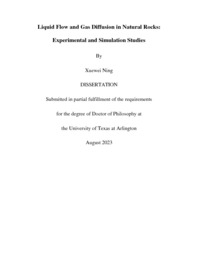| dc.description.abstract | Natural rocks, as key components in energy and environmental geosciences, play crucial roles in groundwater extraction, geological storage of high-level nuclear waste, geothermal energy mining, and petroleum exploration in both conventional and unconventional reservoirs. Unconventional reservoirs, specifically the tight shale formations, have seen a significant usage in petroleum production in recent decades, largely due to advances in fracturing stimulation techniques which counter the inherently low permeability and connectivity of shale reservoirs by expanding natural fractures and creating artificial ones for an enhanced petroleum production. However, the low mobility (liquid flow and gas diffusion) of stored fluids in naturally fractured formations with tight matrix blocks presents a challenge; consequently, understanding liquid flow and gas diffusion in fractured low-permeability media has become a paramount issue in porous media studies.
This research combines integrated methodologies of experimental and simulation studies (numerical and machine learning regression models) to delve into the processes of spontaneous imbibition and gas diffusion, respectively, within various porous natural rocks such as shales, sandstones and carbonate rocks.
For the imbibition analysis, several Barnett Shale samples with fractures were examined with flow direction oriented either parallel (P) or transverse (T) to the bedding plane. A newly developed model, integrating concepts of percolation theory implemented via MATLAB, allows for capturing 3D porous media imbibed with 2D fractures, an innovation over previous piston-like or multiply-sized pore models. The model incorporates the complex interplay of factors, such as porosity, fracture distribution, and pore connectivity. Results demonstrate a sensitivity of imbibed water mass to the number of fractures directly connected to the water source, importing a novel parameter for understanding the wetting-front progression in fractured tight shale.
Subsequently, we utilize machine learning regression techniques, specifically linear regression, Gradient Boosting regression, Decision Tree regression, and Random Forest regression, to predict gas diffusion across 15 different types of rocks with both heterogenous and homogeneous structures. We prioritize attributes such as rock type, sample radius, sample height, porosity, permeability, and tracer concentration difference for their impacts on diffusion velocity and the feature importance. Notably, the Random Forest model identifies the tested gas concentration difference as the most significant factor in affecting gas diffusion.
Our dual-method (experimental and simulation) approach offers valuable insights into liquid flow and gas diffusion behavior in natural rocks, providing a platform for their targeted usage in energy and environmental geosciences. Machine learning models can expedite and economize the testing process, highlighting their potential to enhance operational efficiency in the studies of porous media.
This dissertation is structured into five chapters. The first chapter (Chapter I) provides an overview and succinct introduction to the contents of the subsequent chapters. Chapter II features a paper that has already been published, showcasing the liquid imbibition into fractured Barnett Shale. In Chapter II, the research elucidates the intricate imbibition mechanism prevalent in fractured shale formations. Additionally, it offers a versatile model suitable for Barnett Shale lithology, delineating the spatial-temporal dynamics during fluid imbibition within porous substrates. Chapter III scrutinizes the impact of pore throat distribution and mineralogical constitution on the velocity and amplitude of spontaneous fluid imbibition across a diverse range of natural lithologies. Chapter IV elucidates the proficiency and precision of machine learning models in predicting the gas diffusion process within natural rock matrices. The findings underscore the Random Forest model's aptitude in delineating feature significance and quantifying the contributing attributes for gas diffusion. Chapter V draws conclusions by synthesizing the findings and implications of this research during the duration of this PhD program. | |


